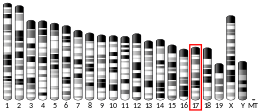Notch 4
Neurogenic locus notch homolog 4 also known as notch 4 is a protein that in humans is encoded by the NOTCH4 gene located on chromosome 6.[5]
Gene
An alternative splice variant of the NOTCH4 gene has been described, but its biological significance has not been determined.[6]
Structure
The neurogenic locus notch homolog 4 protein is a member of the Notch family. Members of this type 1 transmembrane protein family share structural characteristics. These include an extracellular domain consisting of multiple epidermal growth factor-like (EGF) repeats, and an intracellular domain that consists of multiple, but different, domain types.
Function
Notch protein family members play a role in a variety of developmental processes by controlling cell fate decisions. The Notch signaling pathway is an evolutionarily conserved intercellular signaling pathway that regulates interactions between physically adjacent cells
In Drosophilia, notch interacts with its cell-bound ligands (delta and serrate), and establishes an intercellular signaling pathway that then plays a key role in development. Homologues of the notch-ligands have also been identified in humans, but precise interactions between these ligands and the human notch homologues remain to be determined. The notch protein is cleaved in the trans-Golgi network, and then presented on the cell surface as a heterodimer. The protein functions as a receptor for membrane bound ligands, and may play a role in vascular, renal, and hepatic development.[6]
Clinical significance
Mutations in the notch4 gene may be associated with susceptibility to schizophrenia in a small portion of cases.[7]
References
- ENSG00000238196, ENSG00000204301, ENSG00000232339, ENSG00000223355, ENSG00000235396, ENSG00000206312 GRCh38: Ensembl release 89: ENSG00000234876, ENSG00000238196, ENSG00000204301, ENSG00000232339, ENSG00000223355, ENSG00000235396, ENSG00000206312 - Ensembl, May 2017
- GRCm38: Ensembl release 89: ENSMUSG00000015468 - Ensembl, May 2017
- "Human PubMed Reference:". National Center for Biotechnology Information, U.S. National Library of Medicine.
- "Mouse PubMed Reference:". National Center for Biotechnology Information, U.S. National Library of Medicine.
- Sugaya K, Fukagawa T, Matsumoto K, Mita K, Takahashi E, Ando A, Inoko H, Ikemura T (Feb 1995). "Three genes in the human MHC class III region near the junction with the class II: gene for receptor of advanced glycosylation end products, PBX2 homeobox gene and a notch homolog, human counterpart of mouse mammary tumor gene int-3". Genomics. 23 (2): 408–19. doi:10.1006/geno.1994.1517. PMID 7835890.
- "Entrez Gene: NOTCH4 Notch homolog 4 (Drosophila)".
- Shayevitz C, Cohen OS, Faraone SV, Glatt SJ (July 2012). "A re-review of the association between the NOTCH4 locus and schizophrenia". Am. J. Med. Genet. B Neuropsychiatr. Genet. 159B (5): 477–83. doi:10.1002/ajmg.b.32050. PMID 22488909.
Further reading
- Artavanis-Tsakonas S, Rand MD, Lake RJ (1999). "Notch signaling: cell fate control and signal integration in development". Science. 284 (5415): 770–6. Bibcode:1999Sci...284..770A. doi:10.1126/science.284.5415.770. PMID 10221902.
- Mumm JS, Kopan R (2001). "Notch signaling: from the outside in". Dev. Biol. 228 (2): 151–65. doi:10.1006/dbio.2000.9960. PMID 11112321.
- Kojika S, Griffin JD (2001). "Notch receptors and hematopoiesis". Exp. Hematol. 29 (9): 1041–52. doi:10.1016/S0301-472X(01)00676-2. PMID 11532344.
- Allenspach EJ, Maillard I, Aster JC, Pear WS (2003). "Notch signaling in cancer". Cancer Biol. Ther. 1 (5): 466–76. doi:10.4161/cbt.1.5.159. PMID 12496471.
- Wang Z, Wei J, Zhang X, et al. (2007). "A review and re-evaluation of an association between the NOTCH4 locus and schizophrenia". Am. J. Med. Genet. B Neuropsychiatr. Genet. 141 (8): 902–6. doi:10.1002/ajmg.b.30383. PMID 16894623.
- Matsuno K, Diederich RJ, Go MJ, et al. (1995). "Deltex acts as a positive regulator of Notch signaling through interactions with the Notch ankyrin repeats". Development. 121 (8): 2633–44. PMID 7671825.
- Uyttendaele H, Marazzi G, Wu G, et al. (1996). "Notch4/int-3, a mammary proto-oncogene, is an endothelial cell-specific mammalian Notch gene". Development. 122 (7): 2251–9. PMID 8681805.
- Sugaya K, Sasanuma S, Nohata J, et al. (1997). "Gene organization of human NOTCH4 and (CTG)n polymorphism in this human counterpart gene of mouse proto-oncogene Int3". Gene. 189 (2): 235–44. doi:10.1016/S0378-1119(96)00857-8. PMID 9168133.
- Uyttendaele H, Soriano JV, Montesano R, Kitajewski J (1998). "Notch4 and Wnt-1 proteins function to regulate branching morphogenesis of mammary epithelial cells in an opposing fashion". Dev. Biol. 196 (2): 204–17. doi:10.1006/dbio.1998.8863. PMID 9576833.
- Li L, Huang GM, Banta AB, et al. (1998). "Cloning, characterization, and the complete 56.8-kilobase DNA sequence of the human NOTCH4 gene". Genomics. 51 (1): 45–58. doi:10.1006/geno.1998.5330. PMID 9693032.
- Gray GE, Mann RS, Mitsiadis E, et al. (1999). "Human ligands of the Notch receptor". Am. J. Pathol. 154 (3): 785–94. doi:10.1016/S0002-9440(10)65325-4. PMC 1866435. PMID 10079256.
- Imatani A, Callahan R (2000). "Identification of a novel NOTCH-4/INT-3 RNA species encoding an activated gene product in certain human tumor cell lines". Oncogene. 19 (2): 223–31. doi:10.1038/sj.onc.1203295. PMID 10645000.
- Wei J, Hemmings GP (2000). "The NOTCH4 locus is associated with susceptibility to schizophrenia". Nat. Genet. 25 (4): 376–7. doi:10.1038/78044. PMID 10932176.
- Suzuki T, Aoki D, Susumu N, et al. (2001). "Imbalanced expression of TAN-1 and human Notch4 in endometrial cancers". Int. J. Oncol. 17 (6): 1131–9. doi:10.3892/ijo.17.6.1131. PMID 11078798.
- Wu L, Aster JC, Blacklow SC, et al. (2001). "MAML1, a human homologue of Drosophila mastermind, is a transcriptional co-activator for NOTCH receptors". Nat. Genet. 26 (4): 484–9. doi:10.1038/82644. PMID 11101851.
- Kusano S, Raab-Traub N (2001). "An Epstein-Barr virus protein interacts with Notch". J. Virol. 75 (1): 384–95. doi:10.1128/JVI.75.1.384-395.2001. PMC 113931. PMID 11119607.
- Sklar P, Schwab SG, Williams NM, et al. (2001). "Association analysis of NOTCH4 loci in schizophrenia using family and population-based controls". Nat. Genet. 28 (2): 126–8. doi:10.1038/88836. PMID 11381257.



